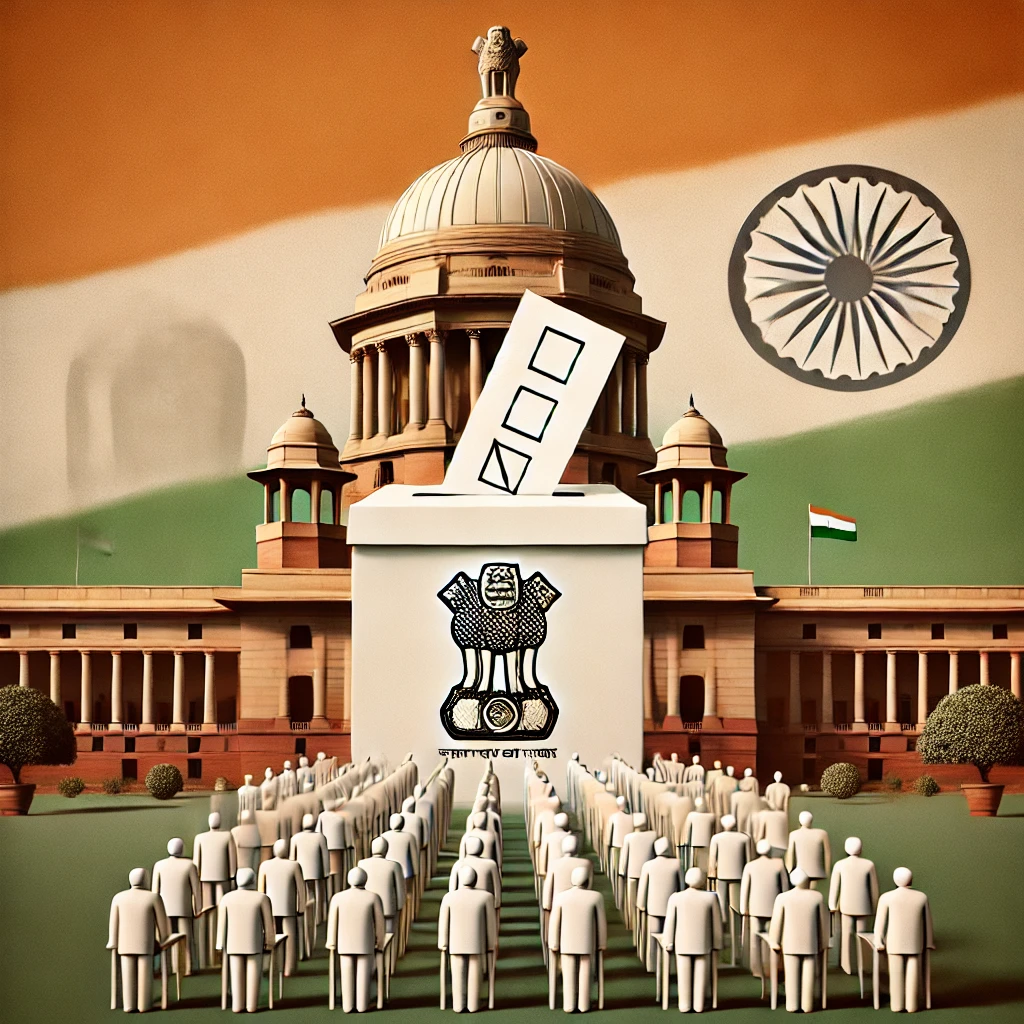Introduction
The President of India is the constitutional head of the country, acting as the supreme executive authority while functioning within the framework of a parliamentary democracy. Unlike in a presidential system, where the head of state exercises real power, in India, the President primarily functions as a ceremonial figurehead, with real executive powers resting with the Council of Ministers, headed by the Prime Minister.
The election process of the President of India is a well-structured mechanism that ensures a balance between the Centre and the States. The system of proportional representation and weighted voting gives fair representation to both levels of government, maintaining the federal character of India.
This essay discusses the eligibility criteria, election process, voting method, constitutional provisions, and how the system ensures Centre-State balance in the Indian political framework.
Constitutional Provisions Related to the President’s Election
The election process of the President is governed by the Indian Constitution and various legal provisions, primarily:
- Article 52: Mandates that India shall have a President.
- Article 54: Describes the electoral process of the President.
- Article 55: Lays down the principle of proportional representation and single transferable vote.
- Article 56: Defines the term of office (five years) but allows re-election.
- Article 57: States that a President can seek re-election any number of times.
- Article 58: Specifies the eligibility criteria to become the President.
- Article 62: Provides for the election process in case of vacancy.
- The Presidential and Vice-Presidential Elections Act, 1952 regulates the procedures.
These provisions collectively ensure a structured election process, preventing political dominance by any single entity.
Eligibility Criteria to Become the President of India
As per Article 58 of the Constitution, a person must fulfill the following conditions to be eligible for the office of the President:
- Citizenship: Must be a citizen of India.
- Age Requirement: Must be at least 35 years old.
- Qualification for Lok Sabha: Must be qualified to be elected as a Member of Parliament (MP) in the Lok Sabha.
- No Office of Profit:
- The candidate must not hold any government office (except ceremonial positions like the Vice-President, Governor, or Minister).
These conditions ensure that only experienced and politically competent individuals contest for the highest constitutional office.
Election Process of the President of India
1. Electoral College for Presidential Elections
The President is elected indirectly by an Electoral College, consisting of:
- Elected Members of Parliament (MPs) from both Lok Sabha and Rajya Sabha.
- Elected Members of Legislative Assemblies (MLAs) from all States and Union Territories with Legislatures (like Delhi, Puducherry, and Jammu & Kashmir).
Nominated members (like Anglo-Indian representatives or Rajya Sabha nominees) are not eligible to vote.
This system ensures that both the Centre and the States have a say in electing the head of the nation, strengthening the federal structure.
2. Voting System: Proportional Representation and Weighted Voting
The President of India is elected through an indirect election based on the proportional representation system using a single transferable vote (STV). This system ensures that the election is fair and representative of both national and state political dynamics.
A. Value of Votes in Presidential Elections
The value of votes is calculated differently for MPs and MLAs to ensure proportional representation.
(i) Value of an MLA’s Vote
The value of an MLA’s vote depends on the population of the state, calculated as:
Value of MLA’s vote=Total Population of the State (as per 1971 Census)Total elected MLAs of the State×1000\text{Value of MLA’s vote} = \frac{\text{Total Population of the State (as per 1971 Census)}}{\text{Total elected MLAs of the State}} \times 1000Value of MLA’s vote=Total elected MLAs of the StateTotal Population of the State (as per 1971 Census)×1000
For example:
- The value of an MLA’s vote in Uttar Pradesh (largest state by population) is much higher than in smaller states like Sikkim or Goa.
- This ensures states with larger populations have greater representation in the election.
(ii) Value of an MP’s Vote
Since both the Lok Sabha and Rajya Sabha MPs vote, their value is calculated as:
Value of an MP’s vote=Total value of all MLAs’ votes in the countryTotal number of elected MPs\text{Value of an MP’s vote} = \frac{\text{Total value of all MLAs’ votes in the country}}{\text{Total number of elected MPs}}Value of an MP’s vote=Total number of elected MPsTotal value of all MLAs’ votes in the country
This formula ensures that parliamentary representation balances out state representation, creating a federal equilibrium.
3. Voting Method: Single Transferable Vote (STV) System
The Single Transferable Vote (STV) system is used to ensure fair representation.
- Preferential Voting: Voters rank candidates in order of preference (1st choice, 2nd choice, etc.).
- Winning Majority: A candidate must secure more than 50% of the total votes (quota) to win.
- Vote Transfer: If no candidate achieves a majority in the first round, the least-preferred candidate is eliminated, and votes are transferred based on second preferences.
- This method ensures a consensus-based selection rather than a simple majority election.
Ensuring Balance Between the Centre and the States
The election process is carefully structured to balance power between the Centre and the States in the following ways:
1. Equal Representation to States and the Centre
- By including both MPs and MLAs, the process prevents dominance by either Parliament or State Legislatures.
- Larger states get greater representation (due to MLA vote values), but MPs’ votes maintain national balance.
2. Protection of Federalism
- The system prevents complete central control over the election. States have a crucial role in electing the President, ensuring their interests are protected.
- The quota-based weighted voting system prevents the overrepresentation of smaller states while ensuring proportional federal power-sharing.
3. Stability Through Indirect Election
- Unlike direct elections (as in the USA), which could lead to political instability and populism, India’s system ensures the President remains a neutral and consensus-based leader.
- The indirect election mechanism strengthens the parliamentary democracy by making the President accountable to the elected representatives of the people rather than to the people directly.
4. Preventing Political Monopoly
- The STV system prevents any one political party from dominating the election.
- Coalition politics and regional party influence are also considered, maintaining a federal balance.
Recent Trends and Challenges in Presidential Elections
1. Impact of Coalition Politics
- In coalition governments, regional parties play a decisive role in Presidential elections.
- Example: In 2012, the UPA’s Presidential candidate Pranab Mukherjee won after securing regional party support.
2. Role of Political Bargaining
- Presidential elections often witness political negotiations where states and regional parties leverage their votes in return for policy concessions.
3. Need for Census Update in Vote Value Calculation
- The current formula uses the 1971 Census for population calculations.
- A new census update could alter vote values, changing state-wise influence in elections.
4. Increasing Partisanship
- Although the President is meant to be a neutral figure, recent elections have seen strong political polarization in voting patterns.
Conclusion
The election process of the President of India is a meticulously designed system that balances the unitary and federal structure of the country. By involving both MPs and MLAs in a weighted proportional representation system, it ensures state interests are safeguarded while maintaining national unity.
However, challenges such as political bargaining, outdated census data, and partisanship pose threats to its fairness. Strengthening electoral transparency and maintaining the constitutional neutrality of the President are crucial for preserving the spirit of federalism in India.




